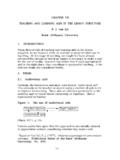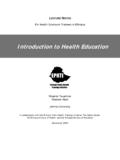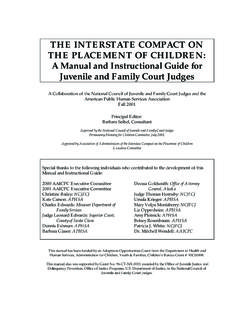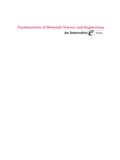Transcription of EDUCATION WHITE PAPER 6 - Whole Schooling
1 EDUCATION WHITE PAPER 6 Special Needs EducationBuilding an inclusive EDUCATION and training May 20012 CONTENTS PAGEI ntroduction by the Minister of Education5 Executive Summary7 chapter 1:WHAT IS AN INCLUSIVE EDUCATION AND TRAININGSYSTEM? WHITE PAPER The Current Profile and Distribution of Special Schools andLearner is Inclusive EDUCATION and Training? An Inclusive EDUCATION and Training System:The First and Other Infectious Diseases23 chapter 2:THE FRAMEWORK FOR ESTABLISHING AN INCLUSIVEEDUCATION AND TRAINING The Framework for Establishing an Inclusive EDUCATION andTraining and Training Policies, Legislation,Advisory Bodies and Governance and EDUCATION Support Provision and EDUCATION and , Assessment and Quality , Advocacy and and other Infectious Strategy34 chapter 3: FUNDING Success Expenditure Access and attached to Expanding Access and of Provincial EDUCATION and Training and Higher Time 4:ESTABLISHING THE INCLUSIVE EDUCATION ANDTRAINING Long Term Short to Medium Term Areas of Building Capacity in all EDUCATION Strengthening the Capacities of all Advisory Bodies Establishing District Support Auditing and improving the quality of and converting Special4 Schools to Resources Identifying, designating and establishing Full Service Schools,Public Adult Learning Centres, and Further and HigherEducation Establishing Institutional Level Support Assisting in establishing mechanisms at community level forthe Early Identification of Severe Learning Developing the professional capacity of all educators inCurriculum Development and Promoting Quality Assurance and Quality Mobilising Public HIV/ aids and other Infectious Developing an Appropriate Funding Strategy48 Annexure A495 INTRODUCTION BY THE MINISTER OF EDUCATIONWhen I announced the Implementation Plan for Tirisano.
2 I noted with regret that ournational and system-wide response to the challenge of Special EDUCATION would bedelayed but brought to the public as soon as we had analysed the comment on theConsultative PAPER (Department of EDUCATION . Consultative PAPER No. 1 on SpecialEducation: Building an Inclusive EDUCATION and Training System. August 30, 1999). I amtherefore glad to announce our response in this WHITE am especially pleased that I have had the opportunity to take personal ownership of aprocess so critical to our EDUCATION and training system which begun some five years agoin October 1996 with the appointment of the National Commission on Special Needs inEducation and Training and the National Committee on EDUCATION Support Services. I saythis because I am deeply aware of the concerns shared by many parents, teachers,lecturers, specialists and learners about the future of special schools and specialisedsettings in an inclusive EDUCATION and training system.
3 They share these concernsbecause they worry about what kind of educational experience would be available tolearners with moderate to severe disabilities in mainstream EDUCATION . I understand theseconcerns, especially now, after I have observed what a difference special schools canmake when they provide a quality and relevant learning this WHITE PAPER , we make it clear that special schools will be strengthened rather thanabolished. Following the completion of our audit of special schools, we will developinvestment plans to improve the quality of EDUCATION across all of them. Learners withsevere disabilities will be accommodated in these vastly improved special schools, as partof an inclusive system. In this regard, the process of identifying, assessing and enrollinglearners in special schools will be overhauled and replaced by structures thatacknowledge the central role played by teachers, lecturers and parents. Given theconsiderable expertise and resources that are invested in special schools, we must alsomake these available to neighbourhood schools, especially full-service schools andcolleges.
4 As we outline in this WHITE PAPER , this can be achieved by making specialschools, in an incremental manner, part of district support services where they canbecome a resource for all our am also deeply aware of the anxieties that many teachers, lecturers, parents andlearners hold about our inclusion proposals for learners with special EDUCATION fear the many challenges that may come with inclusion - of teaching, communication,costs, stereotyping and the safety of learners - that can be righted only by furtherprofessional and physical resources development, information dissemination andadvocacy. We address these concerns also in this WHITE with thirty and expanding up to 500 schools and colleges, we will incrementallydevelop full-service school and college models of inclusion that can in the long term beconsidered for system-wide application. In this manner the Government is demonstratingits determination that through the development of models of inclusion we can take the firststeps of implementing our policy goal of WHITE PAPER , together with EDUCATION WHITE PAPER 5 on Early ChildhoodDevelopment completes an extraordinary period of seven years of post-apartheid policydevelopment and policy making outlined in EDUCATION WHITE PAPER 1 on EDUCATION andTraining that began in the final quarter of 1994.
5 It is a policy PAPER that took us more timeto complete than any of the five macro-systems policies that it follows upon. This meansthat is has benefited the most from our early experience and knowledge of the complexinterface of policy and is therefore another post-apartheid landmark policy PAPER that cuts our ties with the pastand recognises the vital contribution that our people with disabilities are making and mustcontinue to do, but as part of, not isolated from the flowering of our hold out great hope that through the measures that we put forward in this WHITE Paperwe will also be able to convince the thousands of mothers and fathers of some 280,000disabled children - who are younger than 18 years and are not in schools or colleges - thatthe place of these children is not one of isolation in dark backrooms and sheds. It is withtheir peers, in schools, on the playgrounds, on the streets and in places of worship wherethey can become part of the local community and cultural life, and part of thereconstruction and development of our country.
6 For, it is only when these ones among usare a natural and ordinary part of us that we can truly lay claim to the status of cherishingall our children and exclusion were the decadent and immoral factors that determined the place ofour innocent and vulnerable children. Through this WHITE PAPER , the Government isdetermined to create special needs EDUCATION as a non-racial and integrated component ofour EDUCATION wish to take this opportunity to invite all our social partners, members of the public andinterested organisations to join us in this important and vital task that faces us: of buildingan inclusive EDUCATION system. Let us work together to nurture our people with disabilitiesso that they also experience the full excitement and the joy of learning, and to providethem, and our nation, with a solid foundation for lifelong learning and development. Iacknowledge that building an inclusive EDUCATION and training system will not be will be required of us all is persistence, commitment, co-ordination, support,monitoring, evaluation, follow-up and Kader Asmal, MPMinister of Education7 EXECUTIVE SUMMARY1.
7 In this WHITE PAPER we outline what an inclusive EDUCATION and training system is,and how we intend to build it. It provides the framework for establishing such aneducation and training system, details a funding strategy, and lists the key steps tobe taken in establishing an inclusive EDUCATION and training system for South In October 1996, the Ministry of EDUCATION appointed the National Commission onSpecial Needs in EDUCATION and Training and the National Committee on EducationSupport Services to investigate and make recommendations on all aspects of special needs and support services in EDUCATION and training in South A joint report on the findings of these two bodies was presented to the Minister ofEducation in November 1997, and the final report was published by the Departmentof EDUCATION in February 1998 for public comment and advice (Report of NationalCommission on Special Needs in EDUCATION and Training and National Committeeon EDUCATION Support, Department of EDUCATION , 1997).
8 4. The central findings of the investigations included: (i) specialised EDUCATION andsupport has predominantly been provided for a small percentage of learners withdisabilities within special schools and classes; (ii) where provided, specialisededucation and support was provided on a racial basis, with the best human,physical and material resources reserved for whites; (iii) most learners withdisability have either fallen outside of the system or been mainstreamed by default;(iv) the curriculum and EDUCATION system as a Whole have generally failed torespond to the diverse needs of the learner population, resulting in massivenumbers of drop-outs, push-outs, and failures; and, (v) while some attention hasbeen given to the Schooling phase with regard to special needs and support , theother levels or bands of EDUCATION have been seriously In the light of these findings, the joint report of the two bodies recommended thatthe EDUCATION and training system should promote EDUCATION for all and foster thedevelopment of inclusive and supportive centres of learning that enable all learnersto participate actively in the EDUCATION process so that they can develop and extendtheir potential and participate as equal members of The principles guiding the broad strategies to achieve this vision included:acceptance of principles and values contained in the Constitution and WHITE Paperson EDUCATION and Training; human rights and social justice for all learners;participation and social integration; equal access to a single, inclusive educationsystem; access to the curriculum, equity and redress.
9 Community responsiveness;and The report also suggested that the key strategies required to achieve this visionincluded: (i) transforming all aspects of the EDUCATION system, (ii) developing anintegrated system of EDUCATION , (iii) infusing special needs and support services 8throughout the system, (iv) pursuing the holistic development of centres of learningto ensure a barrier-free physical environment and a supportive and inclusivepsycho-social learning environment, developing a flexible curriculum to ensureaccess to all learners, (v) promoting the rights and responsibilities of parents,teachers and learners, (vi) providing effective development programmes foreducators, support personnel, and other relevant human resources, (vii) fosteringholistic and integrated support provision through inter-sectoral collaboration, (viii)developing a community-based support system which includes a preventative anddevelopmental approach to support and, (ix)
10 Developing funding strategies thatensure redress for historically disadvantaged communities and institutions,sustainability, and ultimately access to EDUCATION for all Based on the recommendations in the joint report, the Ministry released aConsultative PAPER (Department of EDUCATION . Consultative PAPER No. 1 on SpecialEducation: Building an Inclusive EDUCATION and Training System. August 30, 1999).The submissions and feedback of social partners and the wider public were collatedand have informed the writing of this WHITE In this WHITE PAPER , we outline the Ministry of EDUCATION s commitment to theprovision of educational opportunities in particular for those learners whoexperience or have experienced barriers to learning and development or who havedropped out of learning because of the inability of the EDUCATION and training systemto accommodate their learning needs. We recognise that our vision of an inclusiveeducation and training system can only be developed over the long term and thatthe actions we will take in the short to medium term must provide us with models forlater system-wide application.






